The Library of Spanking Fiction: Wellred Weekly
|
||||||
|
Articles
Items of interest regarding all things spanking
|
||||||
|
|
German Winter Traditions Involving the Birch Rod 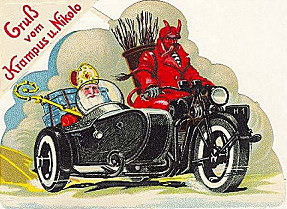 Saint Nicholas & Krampus This sounds like a nice tradition and one would expect German children to thoroughly enjoy this day. Strangely, however, St. Nicholas Day always evokes very mixed feelings of both hope and fear and on old pictures depicting this event we are more likely to see scared faces rather than happy ones, a phenomenon which can still be observed, especially in Bavaria, Austria and Switzerland. The reason for it is that the pious St. Nicholas is often accompanied by some evil looking creatures. In the north it's mostly Knecht Ruprecht and in Bavaria it's the Krampus whose name derives from the Old High German word for claw (Krampen), but many regions have their own specific beasts such as Rumpelklas and Pelznickel. Other countries have equivalent figures, for example, in the German part of Switzerland, Samichlaus, the Swiss equivalent of St. Nicholas, is accompanied by the Schmutzli (meaning 'filthy') while in the Eastern regions of France St. Nicholas's sidekick is known as Père Fouettard (from 'whip'). Despite all the different names they all tend to have in common a devilish goat look (with horns, long tongue and a long tail) and a birch rod in hand which they carry in order to punish the naughty children. 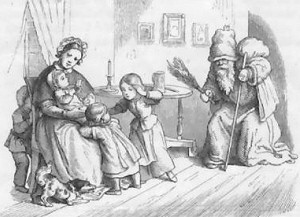 Knecht Rupert The most common routine, however, is that St. Nicholas and Knecht Ruprecht (or Krampus) come to the home. What happens there is told in one of the most popular Christmas poems, which many Germans can still recite in full. Written by Theodor Storm in 1864, Knecht Ruprecht knocks on the door with his birch rod. He then informs the family that he has come from the forest where he met the Holy Christ who is already prepared for Christmas and who told him to hurry up. The Holy Christ (Christkind) then asks him how many children he has still to visit and if he has his sack containing the presents. Then he continues with: 'The rod's there too,' I did reply; but only for those, those naughty ones who have it applied to their backsides.' The Christ-child spoke: 'Then that's all right! My loyal servant, go with God this night! Now speak, what is there here to be had? Are there good children, are there bad? What most Germans don't know is that the poem was originally featured in a play and continues as follows: "The children are generally good, but sometimes a little bit defiant too." Knecht Ruprecht: "Well, well, when it comes to bratty children my long rod comes into good use. Don't you say once in a while: Head down and drop your pants?" father: "The moment one sins, he will be punished; But right now they are good." In this play young Harro only just manages to escape the rod. Another insight into Knecht Ruprecht's task has been provided by Goethe, who also contributed to this aspect of Christmas. His poem Death of a Christmas tree begins: whips the forester's boys like a shepherd, And the fir trees shiver, sensing the cruel axe coming. 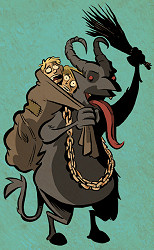 Krampus At this point some explanation about the nature and provenance of Knecht Ruprecht, Krampus and Co. are needed. Why is the kind-hearted St. Nicholas conniving with demons? Why do they work together and how did they meet? One theory states that the presence of demons fits well into Christian, especially Catholic, traditions. As the holy Nicholas is clearly in charge and the demons are only able to act when Nicholas gives them permission, and the Krampuses are also often in chains, this arrangement symbolises that good Christians have nothing to fear, even in the presence of incarnate evil. However, if anyone sins then they will lose this protection and be handed over to the devil. Others say, that Knecht Ruprecht and Krampus have Celtic origins. That all these fur-coated, horned, noise-making, rod-swinging creatures belong in one way or another to the group of Perchten who used to drive out the winter around the time of Twelfth Night (Epiphany) and have their roots in the feast of Perchta, another legendary figure predominantly known in the Alpine region. As the name of Knecht Ruprecht comes from 'ruhpehrt' (which means 'raw percht'), they could well be right. All sorts of Perchten still populate the Alpine valleys and come out in the 'raw nights' (twelve nights, Rauhnächte), when the weather is cold, the days short and the nights long, to expel ghosts and chastise anybody who dares to be outside. There have been many efforts by the church to abolish these customs. In the 16th century the Catholic Church condemned the wild hunt of the Perchten as superstition but thanks to the relatively isolated nature of the Alpine region the traditions never completely died out, becoming more popular after the secularization of the 19th and 20th centuries. So it's not really surprising that politically correct considerations regarding the rod-swinging Krampuses over the last 25 years failed too. 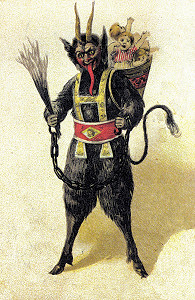 Krampus The Krampuses are mostly banned from kindergarten and schools nowadays but people don't want to abstain completely and a group of liberated Krampuses have started holding their own events. Krampusläufe (Krampus-runs) have traditionally always been popular in Austria, where the creatures invade the town streets on the fifth of December to terrify people, before being put in chains and they then have to follow Nicholas on the following day. During the last decade, however, Krampus runs have become very popular and now take place in more and more towns. Currently, the biggest Krampus run occurs in Salzburg, Austria with up to a thousand participants disguised as Krampuses. Traditionally, only unmarried men and those considered fit for military service take part, wearing diabolical masks, tremendous bells and using their long birch rods on passers-by. The Klausen are distant cousins of the Krampuses and they too hunt through the streets on 5th December, predominantly in Oberallgäu, in order to beat anyone who is out and about. Their roots go back to pre-Christian times and, as they have never been tamed by Nicholas, their rites have always been a little bit wilder. Young men disguise themselves in the most horrible manner in order to scare winter ghosts by shouting, chain-rattling and bell-chiming. The swinging blows with their rods on both persons and objects are intended to drive any suspicious characters away. Some sources also mention that the blows, which were predominantly given to young girls, are believed to increase fertility. With the increasing interest in old traditions during the past 30 years local associations have begun to organise the hunts with a number of restrictions in place. Today all Klausen have to register, need to have insurance and subscribe to a few rules regarding the force of the strokes, not beating little children and respecting safety zones. Having said that, it is still not advisable to nettle the Klausen too much, as they are always on the lookout for any reason to use their rods, especially on young cheeky girls, something they freely confess to on some of their web sites. You can get an impression of the Klausentreiben from numerous videos on YouTube. In the interest of gender equality I would also like to mention the Bärbele-Springen ('Bärbele-Jumping') in Oberstdorf, an activity which can be viewed as the female equivalent of the Klausen's and takes place on the 4th of December, the Feast Day of St. Barbara. Young unmarried women clothed in tatters and masked with moss, fern or grass move around the villages with besoms. Sometimes they go into the houses to brush all the dirty and indecent things away. If someone gets a little too close, however, they may find themselves on the receiving end of some strokes with the besom. This is also supposed to increase fertility. So whatever you have heard about ugly, rude and bastardly Germans, it will all prove to be true if you come and visit Munich, Oberstdorf or Sonthofen in December! During your stay you will have every chance of seeing some disguised creatures scaring little children and hunting people with their birch rods. 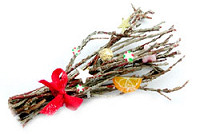 20 comments
|
|||||
| Pages: 1 2 3 4 5 6 7 8 9 10 11 12 13 14 | ||||||


